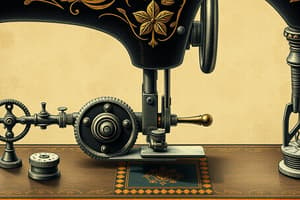Podcast
Questions and Answers
What is the function of the Reverse Lever?
What is the function of the Reverse Lever?
- Holds fabric flat
- Winds the bobbin
- Adjusts stitch length
- Makes the machine sew in reverse (correct)
What is the purpose of the Hand Wheel?
What is the purpose of the Hand Wheel?
Manually advances the sewing machine
The flat part where fabric lays is called the ______.
The flat part where fabric lays is called the ______.
Slide Plate
What does the Pattern Selector do?
What does the Pattern Selector do?
Feed dogs are not crucial for a drop feed sewing machine.
Feed dogs are not crucial for a drop feed sewing machine.
What is the role of the Presser Foot?
What is the role of the Presser Foot?
A stitch length of 2.4 means each stitch will be ______ long.
A stitch length of 2.4 means each stitch will be ______ long.
Where is the Take-up Lever located?
Where is the Take-up Lever located?
The Foot Pedal is operated with the hand.
The Foot Pedal is operated with the hand.
What is the purpose of the Power Switch?
What is the purpose of the Power Switch?
What does a Bobbin do?
What does a Bobbin do?
Flashcards are hidden until you start studying
Study Notes
Sewing Machine Components
-
Reverse Lever: Enables backward sewing to create knots and secure stitches.
-
Hand Wheel: Located at the upper right of the machine, it manually advances the sewing process. It must be turned only in the forward direction to avoid damage.
-
Slide Plate: The flat surface where fabric is placed, containing the throat plate and feed dogs.
-
Bobbin: A small cylindrical spool inside the machine that holds the bottom thread, essential for stitching.
-
Bobbin Case: The compartment beneath the slide plate that securely holds the bobbin in position.
-
Pattern Selector: Adjusts stitch width, including options for zigzag and reverse stitches. It often includes a reverse stitch button and thread guides.
-
Feed Dogs: Critical elements in a "drop feed" sewing machine, these metal bars move back and forth to control fabric feeding through the machine.
-
Presser Foot: An attachment that holds the fabric in place while it is being stitched, essential for consistent sewing.
-
Stitch Length: Indicated in millimeters, it determines the length of each stitch (e.g., a 2.4 stitch length means each stitch is 2.4 mm long). Specific patterns may require particular stitch lengths.
-
Take-up Lever: Located above the presser foot, this component lifts the thread back after a stitch is made and indicates the needle's position.
-
Foot Pedal: Operated by the foot, it controls the machine's sewing speed and motion, allowing easy hands-free operation.
-
Power Switch: The essential control for turning the sewing machine on and off for operation.
-
Bobbin Winder: A device designed for winding thread onto a bobbin, ensuring even distribution of thread for smooth operation.
-
Presser Foot Lifter: A mechanism that raises and lowers the presser foot, often featuring a further bias mechanism for ease of use.
-
Spool Pin: The part of the sewing machine where the thread spool is placed before being guided to the needle.
-
Bobbin Characteristics: A cylindrical spindle that may have flanges, used for winding various materials like thread and yarn, promoting organized storage without tangles.
Studying That Suits You
Use AI to generate personalized quizzes and flashcards to suit your learning preferences.




